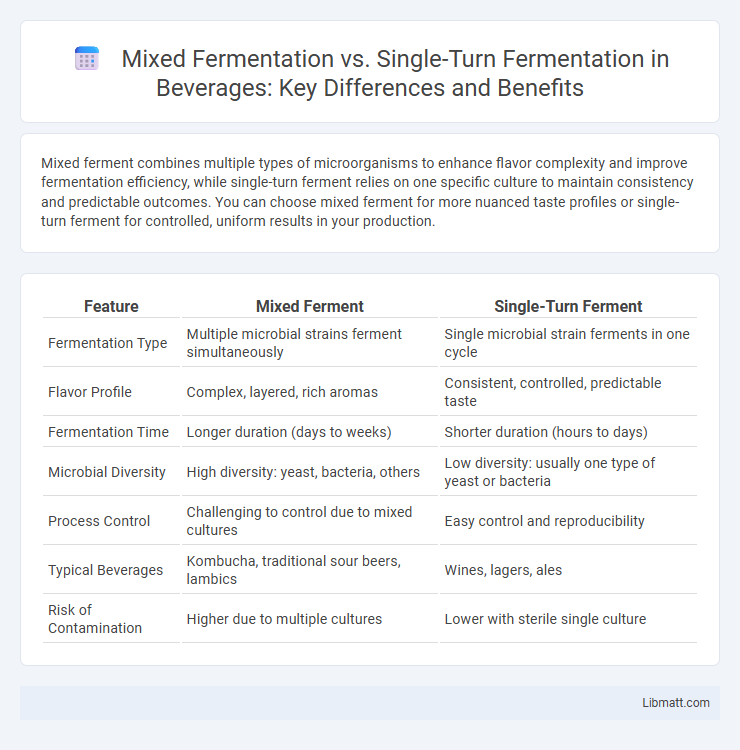Mixed ferment combines multiple types of microorganisms to enhance flavor complexity and improve fermentation efficiency, while single-turn ferment relies on one specific culture to maintain consistency and predictable outcomes. You can choose mixed ferment for more nuanced taste profiles or single-turn ferment for controlled, uniform results in your production.
Table of Comparison
| Feature | Mixed Ferment | Single-Turn Ferment |
|---|---|---|
| Fermentation Type | Multiple microbial strains ferment simultaneously | Single microbial strain ferments in one cycle |
| Flavor Profile | Complex, layered, rich aromas | Consistent, controlled, predictable taste |
| Fermentation Time | Longer duration (days to weeks) | Shorter duration (hours to days) |
| Microbial Diversity | High diversity: yeast, bacteria, others | Low diversity: usually one type of yeast or bacteria |
| Process Control | Challenging to control due to mixed cultures | Easy control and reproducibility |
| Typical Beverages | Kombucha, traditional sour beers, lambics | Wines, lagers, ales |
| Risk of Contamination | Higher due to multiple cultures | Lower with sterile single culture |
Understanding Fermentation: Basics and Terminology
Mixed fermentation involves multiple strains of yeast and bacteria working simultaneously, creating complex flavors and aromas due to diverse metabolic activities. Single-turn fermentation uses a single microorganism strain, producing more predictable and consistent outcomes throughout the process. Grasping these fundamental differences in microbial involvement and metabolic pathways is essential for optimizing fermentation techniques in brewing and food production.
What is Single-Turn Fermentation?
Single-turn fermentation is a controlled fermentation process where the substrate undergoes a single, uninterrupted fermentation cycle, typically resulting in a consistent and uniform end product. Unlike mixed ferment methods that use multiple fermentation stages or varied microorganisms, single-turn fermentation relies on one batch and one microbial community to transform raw materials into desired products such as alcohol, yogurt, or kombucha. This method offers streamlined production, easier quality control, and predictable flavor profiles.
The Principles of Mixed Fermentation
Mixed fermentation relies on the deliberate use of diverse microbial communities, such as bacteria and yeast, working symbiotically to enhance complexity and depth of flavor. This process emphasizes natural microbial succession and interaction, creating unique metabolic byproducts that single-turn fermentations typically lack. The principles focus on promoting environmental conditions that favor balanced microbial growth, resulting in improved aroma profiles and fermentation efficiency.
Key Differences: Mixed Ferment vs Single-Turn Ferment
Mixed ferment uses diverse microbial strains simultaneously, enhancing flavor complexity and aroma profiles through multiple biochemical pathways. Single-turn ferment relies on a single dominant microorganism, resulting in more uniform and predictable product characteristics. The choice between mixed and single-turn ferment significantly impacts fermentation duration, taste depth, and microbial stability in food and beverage production.
Microbial Dynamics in Mixed Fermentation
Mixed fermentation involves diverse microbial communities including yeasts, lactic acid bacteria, and acetic acid bacteria, which interact synergistically to enhance flavor complexity and product stability. Single-turn fermentation relies on one dominant microorganism, resulting in a more predictable but less complex microbial dynamic. Understanding these interactions can help you optimize fermentation processes for improved sensory qualities and microbial safety.
Flavor Profiles: Comparing Mixed and Single-Turn Ferments
Mixed fermentations generate complex flavor profiles with layers of fruity, spicy, and earthy notes due to the interaction of multiple yeast and bacterial strains. Single-turn ferments produce more consistent and straightforward flavors, often highlighting the primary characteristics of the main yeast strain. Understanding these differences helps you choose the ideal fermentation process to achieve your desired taste complexity and balance.
Advantages of Mixed Fermentation Processes
Mixed fermentation processes enhance flavor complexity and aroma profiles by combining the metabolic activities of different microorganisms like yeast and bacteria. These interactions increase production of desirable compounds such as esters, organic acids, and other secondary metabolites, which are less prominent in single-turn fermentations. Additionally, mixed fermentation improves fermentation stability and can reduce spoilage risks by outcompeting unwanted microbes, leading to greater product consistency and quality.
When to Choose Single-Turn Fermentation
Single-turn fermentation is ideal when You need precise control over flavor development and consistent product quality, especially in small-batch or specialty production. This method reduces the risk of contamination and allows for easier monitoring of microbial activity compared to mixed fermentation. Choosing single-turn fermentation suits scenarios where predictability and faster turnaround times are priorities.
Challenges and Considerations in Mixed Fermentation
Mixed fermentation presents challenges such as managing microbial diversity to prevent contamination and ensuring consistent flavor profiles. It requires careful monitoring of fermentation parameters like temperature and pH to maintain optimal growth conditions for multiple microorganisms. Understanding interactions between yeast and bacteria is crucial to avoid off-flavors and ensure product quality.
Future Trends in Fermentation Techniques
Mixed ferment techniques leverage diverse microbial communities to enhance flavor complexity and improve fermentation efficiency, a trend expected to dominate future production methods. Single-turn ferment remains favored for consistency and ease of control, yet innovations are integrating selective microbial strains to optimize outcomes. Your choice between these methods will depend on balancing traditional flavor profiles with emerging biotechnological advancements in fermentation.
Mixed ferment vs single-turn ferment Infographic

 libmatt.com
libmatt.com